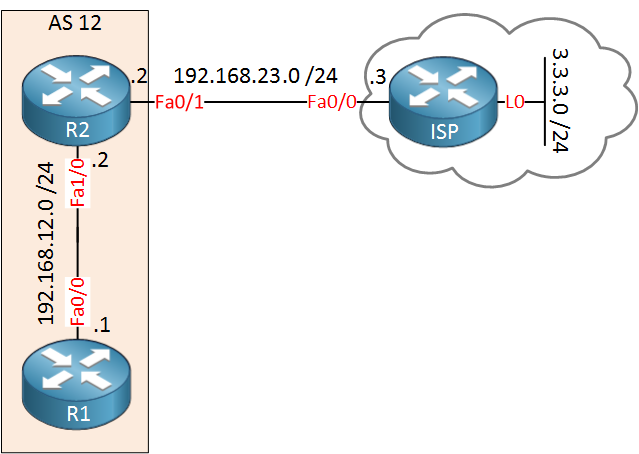Routing - Injecting a Static Route
When injecting a static route into a routing domain of a dynamic routing protocol, it is best practice to inject this route as close as possible to the destination network. This ensures a higher resiliency and a more efficient routing mechanism.
For example, take a look at this topology:

Let's say that we want to introduce a static route to the 3.3.3.0/24 network and we want to inject it into the EIGRP routing protocol on our enterprise network which is composed of R1 and R2. We can inject this static route on R1 like so:
R1(config)#ip route 3.3.3.0 255.255.255.0 192.168.23.3
It instructs R1 to send packets destined to 3.3.3.0/24 to the IP address of the ISP router. We can then inject this route into EIGRP by issuing the following command under the EIGRP router configuration:
R1(config-router)#redistribute connected
The result is a static route in the Routing Table which will be redistributed into EIGRP. Thus, R2 will learn about this static route and the appropriate next hop.
There are a couple of disadvantages to this.
- This static routing entry requires recursive routing since the next hop is not directly connected. This is generally inefficient and should be avoided whenever possible.
- There are now two single points of failure for the routing of this network:
- If R1 fails, the static route to 3.3.3.0/24 is removed from the EIGRP topology. Thus, the rest of the network will not know how to get to 3.3.3.0/24 even though there is a perfectly functional path to reach it, thus the network will fail.
- If R2 fails, the static route may remain, but the path to the destination is no longer functional, thus again, the network will fail.
For this reason, the injection of the static route should be performed on the router that is closest to the destination itself. In the above topology, this would be R2. If this were the case, the two single points of failure are reduced to one, since a failure of R1 would not cause a failure of the routing. Secondly, we would avoid any recursive routing since the next hop is directly connected to R2 router.